
Caladiums
by Derek Burch
What costs the same as a 4" annual, has as much color as most annuals, lasts all season, and will do the same the next year given a little consideration during the winter?
The answer is obvious, given the placement of the question. I might have added that, for the Florida gardener, the caladium gives its color all through the summer - a time when it is notoriously difficult to find a bedding plant that will stand the heat and humidity.
2. Caladiums in the Landscape
Nurseries love caladiums as pot plant crops for the spring holidays: white-leaved varieties are a natural for Easter with the splash of vibrant pinks and reds adding to the more festive air of Mother's Day.
There is an increasing interest
on the part of gardeners in caladiums for bedding, or for long-lasting
containers. Garden stores have been quick to supplement the dormant tubers,
that have always been available in spring for knowledgeable gardeners,
with 4- or 6-inch pots in full color that will be impulse buys or that
give the instant effect that we are told many gardeners crave.
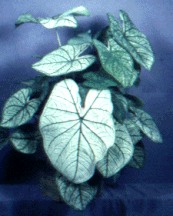 |
 |
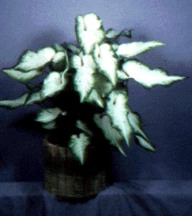 |
|
|
Left to right: Fancy Caladium
'Candidum Jr. Fancy Caladium 'Carolyn
Wharton Lance Caladium 'White Wings'
|
|||
Caladiums are classified as Fancy-leaf, Strap- or Lance-leaf and Dwarf. The names for once are reasonably descriptive: The strap or lance-leaved types have more slender leaves than the fancies, while the dwarfs are smaller in leaf size as well as height. Expect to pay a little more for the straps and dwarfs since they are slower to increase and thus cost the growers more.
|
|
Starting a tuber is simply a matter of planting it with no more than an inch of soil over it, choosing a soil that is both well-drained and able to hold some water. Some cultivars are better with a little shade and others can take a situation in full sun. The breeding programme at the University of Florida Gulf Coast Research Center, Bradenton is developing tubers with multiple eyes, that will grow a plant with many leaves without the need to scoop out the terminal bud to encourage others to grow, as is common indistry practice.. Another old trick used to be to plant the tubers upside down, which would slow growth, but also encourage multiple buds to grow. |
Growth requirements in the garden are simple. Dr. Gary Wilfret, who is in charge of the breeding programme says that if a caladium could talk, it would say "keep me warm and keep me wet." Ample water, a little fertilizer and summer temperatures will meet these requirements very well.
Florida has released a number of cultivars with outstanding characteristics of color and foliage production.
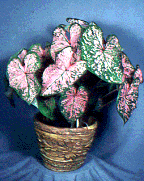 |
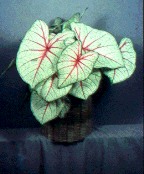 |
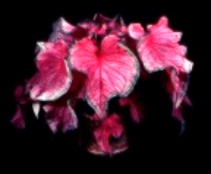 |
Left
to right: Fancy caladiums 'Florida Elise' 'Florida Fantasy' and 'Florida Sweetheart' |
Use caladiums in formal bedding, as container plants for summer-long brightening of a patio or decoration for a special event. Cultivars differ in their ability to flourish in sun or shade, and the choice of the correct varieties will brighten almost any situation.
Tubers are inexpensive enough to abandon at the end of the season, but also easy to store by lifting them as cool weather begins, doing a little cleaning of the attached soil, and then keeping them in a frost-free location. In spring, a little more cleaning and then replanting in a prepared spot will give back a display equal to or better than that of the previous year. In frost-free areas they can stay in the ground unless the space is needed for a winter blooming crop.
Inexpensive, foolproof and very rewarding, the caladium can earn a place in most landscapes.
The editor is grateful to Dr. Gary Wilfret for the use of the pictures in these articles. There are photographs of more cultivars at http://www.hortdigest.com/archives/2-99/gallery.asp. The March 2001 issue of Greenhouse Product News has an article by Terri Bates-Cantwell , the production manager of Bates Sons and Daughters Inc. of Lake Placid Florida, which is a mine of information, and belongs in my "should not be missed" category.
Back to Part 1 of this story
Back to the Table of Contents
